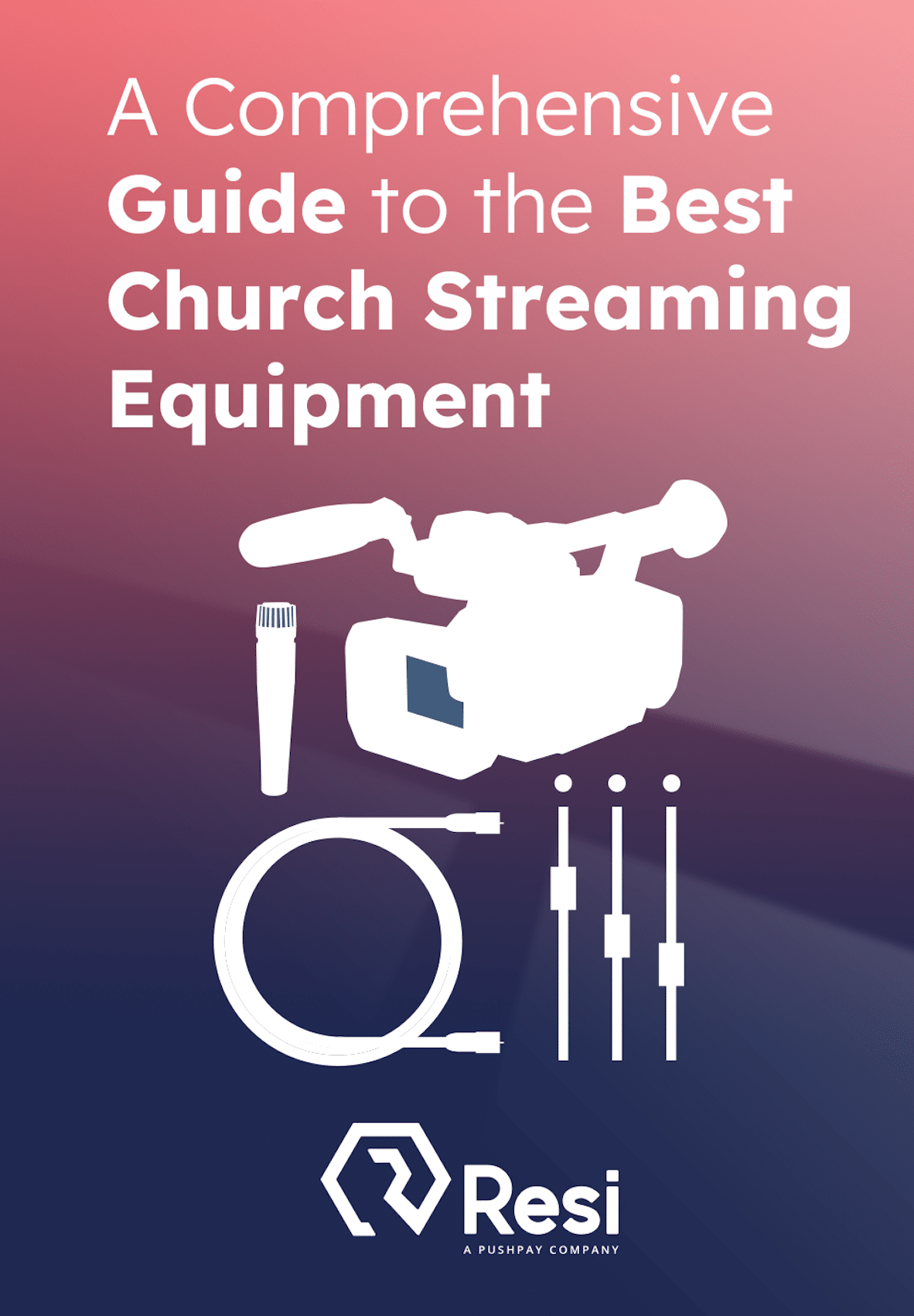
When it comes to church sound systems, it’s important to understand that they serve an entirely different use case than a sound system that might be used by a band or at a theater.
Church sound systems are generally fixed. The sound engineers and crew are often volunteers, which means simplicity in setup and operation is key. Long rectangular rooms (like church auditoriums) with high ceilings can present challenges in managing reverb. Church sound systems need to be able to handle both music and spoken word material, with a greater emphasis on intelligibility over musicality.
Those are just a few of the unique challenges that church sound systems need to be able to handle.
Understanding the Unique Acoustic Challenges of Church Buildings
Church buildings are designed with common features such as high ceilings, expansive open spaces, and hard surfaces like wood. These features, beautiful as they may be, present unique acoustic challenges that can complicate sound management.
High Ceilings and Large Open Spaces
The high ceilings in many churches can cause sounds to bounce and reverberate, leading to echoes that may muddle spoken words and music. Similarly, the large open spaces meant to accommodate a congregation can disperse sound unevenly, making it difficult for everyone to hear clearly, particularly those seated at the back.
Hard Surfaces
Materials like stone, marble, and hardwood, often chosen for their durability and aesthetic appeal, don’t absorb sound well. Instead, they reflect it, causing sound waves to ricochet around the space. This can result in a mix of overlapping sounds, making it challenging to maintain clarity in speech and music.
Comparison with Other Venues
Contrast these acoustic challenges with venues like concert halls and theaters, which are typically designed with acoustics in mind. These venues often feature sound-absorbing materials and strategically placed design elements to manage sound reflection and ensure even distribution. Theaters, for example, may use curtains, padded seats, and other materials that absorb and dampen sound to prevent echo and enhance the audience’s experience.
In comparison, churches face the dual challenge of creating a welcoming environment for a church service while adapting to modern sound requirements. By understanding these unique acoustic challenges, we can better appreciate the importance of choosing a sound system specifically designed for worship environments. The right system can mitigate these issues!
Components of Church Sound Systems
Understanding the unique components that make up a church sound system is crucial for creating an environment where every element of church worship can be heard clearly and felt deeply. Let’s explore the key elements that make up a proper audio system in worship services.
Microphones: Types and Placement
Microphones are the frontline soldiers of any sound system. In a church setting, various types of microphones serve different purposes:
- Lapel and Headset Microphones: These are ideal for pastors and speakers, allowing them to move freely without compromising sound quality. Their placement near the mouth ensures clarity and minimizes background noise.
- Handheld Microphones: These provide flexibility and high-quality sound capture.
- Choir and Instrument Microphones: Placed strategically around choirs and instruments, these mics are designed to pick up multiple sources simultaneously, ensuring that every voice and note is heard.
Proper placement is key to avoiding feedback and ensuring that the sound captured is as natural and clear as possible.
Best Livestreaming Equipment
Discover what top-rated equipment we recommend adding to your church streaming toolkit.
Download for free!
Digital Mixer and Audio Consoles
The digital mixer or digital audio console is the heart of the sound system, where all audio inputs are balanced and controlled. For church services, these devices offer several critical functions:
- Balancing Multiple Inputs: Churches often have numerous sound sources, from microphones to instruments.
- Sound Customization: Digital consoles allow for preset configurations tailored to different parts of the service.
- Ease of Use: Modern digital mixers come with user-friendly interfaces, enabling even those with limited technical knowledge to manage complex audio requirements effectively.
By fine-tuning the sound, mixers ensure that the final output is cohesive and pleasing to the ear.
Speakers and Amplifiers
The speaker system placement and quality significantly impact the listening experience:
- Main Speakers: These should be positioned to cover the entire seating area evenly, ensuring that both the front and back rows hear the same quality of sound.
- Subwoofers: Important for enhancing the richness of music, especially in services with contemporary worship bands.
- Amplifiers: These boost the signal from the mixer to the speakers, ensuring that the sound remains strong and clear across large spaces.
The right combination of speakers and amplifiers helps in overcoming the acoustic challenges posed by large and echo-prone sanctuary environments.
Monitors and In-Ear Systems
To enable performers and speakers can hear themselves and each other, monitors and in-ear systems are indispensable:
- Stage Monitors: These speakers are placed on stage facing the performers, providing real-time audio feedback.
- In-Ear Monitors: These are popular for their ability to deliver personalized mixes directly to individual performers, reducing stage clutter, and minimizing feedback.
Common Challenges and Solutions
Creating an effective church sound system involves navigating several common challenges. Here, we’ll explore these hurdles and provide solutions to ensure your worship services are both impactful and seamless.
Feedback and How to Minimize It
Feedback, that unpleasant squeal or hum, can disrupt the worship service and distract from the message. This issue often arises when microphones pick up sound from speakers and re-amplify it, creating a loop.
Solutions:
- Microphone Placement: Position microphones carefully to avoid direct lines of sight to speakers. Use directional mics when possible, as they pick up sound from specific sources which reduces the likelihood of feedback.
- Equalization: Adjusting the EQ settings on your mixer can help control frequencies that typically cause feedback. Cutting problematic frequencies will minimize the risk without sacrificing audio quality.
- Use of Feedback Suppressors: These devices automatically detect and reduce feedback frequencies.
Achieving Consistent Sound Coverage Throughout the Sanctuary
Ensuring that every attendee hears the service clearly, regardless of where they are seated, is a significant challenge, especially in large or acoustically complex spaces.
Solutions:
- Speaker Placement: Strategically place speakers to cover all seating areas evenly. Consider using additional speakers for larger sanctuaries to ensure consistent sound distribution.
- Sound Field Modeling: Utilize software tools to model your sanctuary’s acoustics and adjust speaker placement and settings accordingly. This helps anticipate and correct potential coverage issues before they become problems.
- Delay Speakers: In larger spaces, delay speakers can be used to maintain sound synchronization, ensuring those seated further back hear the sound in alignment with the front.
Training Volunteers and Staff to Operate the System Effectively
Even the most advanced sound system won’t perform well without knowledgeable operators. Ensuring your volunteers and staff are well-trained is crucial for maintaining high-quality audio.
Solutions:
- Comprehensive Training Programs: Develop training programs that cover all aspects of the sound system, from basic operations to troubleshooting common issues. Include hands-on sessions to build confidence and competence.
- User Manuals and Resources: Provide detailed user manuals and resources that volunteers can refer to when needed.
- Ongoing Support: Establish a support system where experienced team members can assist newer volunteers. Regular refresher courses and advanced training sessions can help keep everyone up-to-date with the latest techniques and technologies.
Navigating these challenges with thoughtful solutions not only enhances the quality of your worship services but also creates a sense of community and shared purpose among those who contribute to the ministry. By addressing these technical aspects with care and precision, we enable a richer, more immersive worship experience for everyone involved.
Improve Your Audio Set Up Today
A good sound system isn’t just a bunch of equipment; it’s key to enhancing the worship experience. Professional installation and regular maintenance make sure everything runs smoothly, ensuring every sermon, song, and prayer is heard loud and clear.
No matter the size or budget of your church, the tips in this blog can help improve your audio setup. The goal is to create a space where worship can thrive and the community can come together in faith. By planning for future growth and tech advancements, you can make sure your sound system serves your congregation for years to come.
Take some time today to assess your current setup and find areas to improve. Get professional help if needed, and train your team to maintain and troubleshoot the system. With careful planning and regular upkeep, your church can enjoy clear, immersive sound every Sunday!








